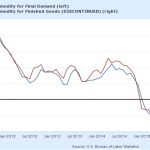A selloff in treasuries extended into the second day on Oct. 3 after investors’ appetite for riskier assets improved following stronger domestic economic data and reports on easing fears of a clash over finances between the EU and Italy.
As treasury prices fell sharply, the 10-year Treasury note hit a multi-year high. Financials rallied on expectations to benefit from a rise in benchmark bond yield. At the same time, this rise in yield bolstered prospects of further rate hikes, leading to a stronger U.S. dollar. Small caps with domestic focus, in the meantime, are better poised to weather a stronger dollar. This category of stocks is cushioned against the loss of competitiveness and currency translation impact of a stronger greenback.
Bond Yields Hit Multi-Year High
The 10-year Treasury yield, used as a reference for everything from mortgages to student debt, rose 10.3 basis points to 3.159% on Oct 3, the highest since July 2011. This also marked its largest one-day climb since March 2017.
The 10-year note yield had crossed the coveted 3% mark on Sep 18, the first time since late May. The benchmark bond yield had exceeded the mark briefly in 2013 and January 2014, which was toward the end of the bond market wipeout, better known as the “taper tantrum.”
The 30-year bond yield, in the meantime, climbed 10.9 basis points to 3.315%, the highest since September 2014. The long-dated maturity also booked its biggest one-day rise since the day after President Trump’s election in November 2016. By the way, the shorter 2-year note yield too was up 4.5 basis points to 2.860%.
What’s Acting in Favor of Bond Yields?
Bond yields are rising as bond prices decline. The bond market is becoming less attractive as investors continue to load up on riskier assets due to a raft of stronger-than-expected economic data and ebbing concerns about the fiscal situation in Italy.
Private sector payrolls surged in September, as employers added 230,000 jobs, per Automatic Data Processing, Inc. ADP. This, in fact, is the highest hiring rate since February and the first of the three reports on the labor market that will be released this week.








Leave A Comment